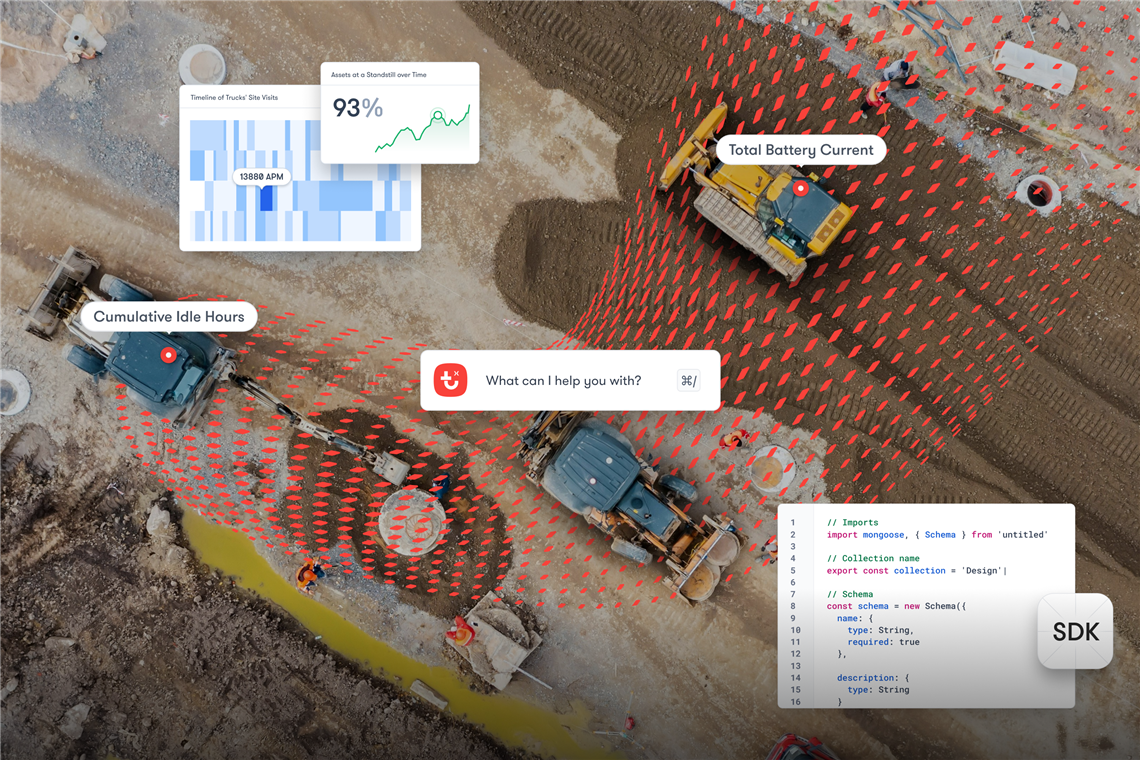Trackunit updates data platform with generative AI
29 August 2024
Machine telematics and data specialist Trackunit is adding generative AI to its Iris operating platform as part of a wider IrisX upgrade. Soeren Brogaard, Trackunit’s CEO, explains all to IRN’s Murray Pollok.
Global machine data and telematics company Trackunit is launching a significant upgrade to its Iris operating data platform incorporating generative AI capabilities. The AI tools included in IrisX will allow for voice or text interrogation of machine data, a feature that Soeren Brogaard says is one of the first such applications “not just in construction, but across the globe.”
“We are breaking new ground with a generative AI interface to your data, based on time series data,” says the Trackunit CEO.
 Soeren Brogaard, CEO of Trackunit. (Photo: Trackunit)
Soeren Brogaard, CEO of Trackunit. (Photo: Trackunit)
The technology will provide an interface where the data acts as a co-pilot or an advisor, as in ChatGPT, he says, “you can have a conversation almost like it was a human…You no longer have to be a developer to write these queries. IrisX will translate your question into code.”
It could mean, for example, asking what machines are coming up for service in a depot or region next month, and generating an alert to depot managers. Or a user could upload service manuals, which IrisX will interpret and correlate to the errors and alarms that the system generates.
“It’s a first release, so it still has its limitations”, says Brogaard, “but it’s very exciting because we are one of the very first, not just in construction but across the globe, that is launching a time series generative AI proposition.”
The addition of generative AI is the most eye-catching of the new features being offered by IrisX, but there are four other significant functionalities being offered, including another that relates to AI.
That will be the ability for allow customers to integrate their own AI-based tools and applications to analyse their own data. “That’s a profound new thing”, says Brogaard, “So far, Trackunit has been using AI tools for our standard applications, but now we also giving our customers that capability in a private, secure instance, so customers can unlock new insights.
“They can even put in their own data, and that allows them to build applications either for internal use or external use.”
Seamless integrations
Also new in IrisX will be an “automation studio” for companies that will allow them to integrate machine data analytics into their other workflows systems in a “seamless” way.
“Machine data is used by customers like rental companies that are putting a rental portal in front of their contractor customers or the end users, where machine data is a vital thing for invoicing, building for service depots, returns, service management, etc.” says Brogaard.
 Graphic showing the capabilities of Trackunit’s IrisX operating data platform. (Image: Trackunit)
Graphic showing the capabilities of Trackunit’s IrisX operating data platform. (Image: Trackunit)
“The data that we provide very often is integrated as part of those work streams when renting, returning, servicing. With the automation studio, we can integrate into those workflow workflows in a seamless way. It’s basically an insertion of the appropriate data into existing workflows in a standardized way.”
Related to that, Trackunit has also included in IrisX more than 100 standardized integrations to external IT systems, whether ERP rental systems or workflow management systems being used by customers.
“It is a big burden today that when you do system to system integrations, you need to spend a lot of time and money to keep those integrations alive and current,” says Brogaard, “With the integration connections that we are launching as part of IrisX, that becomes a more standardized process where we are maintaining the integration from our side.”
Another new feature relates to applications and extensions, and allows customers to develop their own applications in IrisX using its analytics, the automation studio, and standardized integrations.
“As an example, it could be predictive maintenance, or it could be a spare parts finder, or it could be some other safety measures,” says Brogaard, “That application you can deploy on our marketplace.
“We want a marketplace that is exposed to the entire industry - rental, contractors and OEMs. You as an OEM now have a way of getting your applications into the market in a purpose-built marketplace that is seen by thousands of industry players every single day.”
Pricing for IrisX?
Customers are being given the opportunity to add IrisX to their existing Iris platform, with pricing based on the number of “operations” it performs; “We actually look at how many integrations to other systems do you want to build? What type of workflow automation systems do you want to consume from the automation studio? Do you want to launch these applications in the marketplace, or are you doing it internally? How many data queries?
“It will be transparent, and you can cap it, pause it, stop it, and you can dial it up.”
 IrisX will provide more insights based on machine telematics as well as other data sources. (Image: Trackunit)
IrisX will provide more insights based on machine telematics as well as other data sources. (Image: Trackunit)
Brogaard thinks IrisX may initially appeal to larger customers; “I think for the initial launch, it will mostly be more mature IT departments and teams that have appropriate resources to take advantage of this. Longer term, though, I see this going into the mid-market, especially as the generative AI part becomes more mature.”
He says the trend in technology is to make IT solutions “ingenious and approachable and usable by non-developers and non-IT specialists…So, as we reach those maturity stages, then this will be something that I can see small to mid-size rental and OEMs want to start using.”
“Data maturity”
Brogaard views the launch of IrisX, incorporating generative AI, as a consequence both of the new technologies now available and of what he calls “data maturity.”
“What is exciting for both rental and OEMs is that for years they have been very focused on the quality of data, getting the depth of information up to a certain level. We call it data maturity.
“I think we’ve now reached a point where our customers who have been on Iris for many years can start leveraging that in the next generation. And we know that we have a scarce resource when it comes to data scientists and systems engineers.
“The industry has a hard time attracting people, but what we’re trying to do here is give our customers an environment where they could shortcut the path to generative AI and insights and application deployment that can help them differentiate their machines or their services.”
Brogaard says the Iris platform had been the “cornerstone” in developing its Go, Manager and On products, and to stream data into third-party systems. IrisX indicates how the company will develop in the coming years; “What’s happening now is that we are actually ‘productizing’ the underlying layer of what our customers are using, in a standardized way.
“But the platforming aspect of where the company is going in the next four or five years, I think you will see this becoming an even bigger part of how we bring value; the way we leverage modern technology that is evolving faster than any of us can think.”
Digital challenges
Brogaard adds that IrisX is designed to help companies overcome the challenges of digital transformation, such as high upfront investment and the scarcity of tech talent; “By offering a platform that coexists and integrates with existing tools, we ensure faster time to value and impact, making it easier for companies to scale their digital investments.
“Our customers and partners already have experience of building proprietary solutions through Iris. Now IrisX unlocks deep insights and capabilities through integrating AI and machine learning that will specifically target customer pain points such as downtime, maintenance schedules, and keeping track of fleets between sites, to mention just a few.”
He concludes; “This is a purpose built platform that connects, streamlines and empowers data from the back office to the frontlines that takes its place within a wider Cloud and IT architecture.
“The beauty of IrisX is that it co-exists and integrates with all your others tools so customers can choose how much they wish to leverage.”







